I have daydreamed of traveling ever since I was a kid. I would usually hang
out in our school library during lunch and free time and look at all those
books about archaeology, history and exploration. I was ever since fascinated
by a set of army sculptures that have been buried in the ground a long time
ago. I may have forgotten what it was called and where it was excavated, but I
never forgot what it looked like in that book. Years after, I am now working
and planning for my travels that I remembered that image. I looked it up with
keywords “terracotta sculptures” and found out that the picture I saw is in
China and located in the city of Xi’An. On the last
piso sale of 2012, I booked for a flight going to this country.
Aside from
The Great Wall of China, going to the Terracotta Warriors is one of
the must-dos I planned out for my 12-day trip.
 |
| Terracotta Army of Xian, China |
The famous terracotta army of Xian (兵马俑 Bīngmǎyǒng) is an assembly of terracotta sculptures
commissioned during 210 BCE, which depicts the imperial guard of the first
Emperor of China, Emperor Qin Shi Huang. The collection of more than 8,000
soldiers and around 800 horses were buried with the royalty to protect his
burial site until his journey to the afterlife. I suppose it has been a common
idea in different parts of the world, to bury something or someone important to
a person on their burial, most especially to the people of highest positions.
What’s also interesting to know was that upon Emperor Qin’s ascending the
throne of a young age of 13 years old, he had already started the work for this
mausoleum that took 36 years and more than 700,000 laborers to complete.
This 2,000 year-old relics have been located 30 kilometers
east of Xi’An during the 1970s by a group of local farmers digging for a well.
Who would have thought they would unearth a national treasure!
Ever since then,
excavations and restorations have been driven to uncover more of this magnanimous
discovery. According to historians, after the completion of the site, Qin
ordered to kill all the artisans who have worked there to maintain the secrecy
of the tomb’s location and the treasures that were to be buried in time of his
death. This man has been obsessed with immortality that he dedicated 8,000
royal servants to find for the legendary “elixir of life”, which apparently led
to an unsuccessful quest because he died at the age of 50. On a positive note,
the Emperor was greatly known for his great achievements of having been able to
unite the country and joining states by building various roads, canals and other
infrastructure, imposing standardized measurements,
and has also took part on building the plan
for the Great Wall. Such weird quirks for a genius mind! Unfortunately though,
the exact tomb of the Emperor still remains unopened. As told from legends, the
tomb is contained with traps and big amount of mercury which has been proven
even by modern archaeologists. I hope they’d be able to excavate the tomb in my
lifetime.
After my first mishap of not having enough moolah for the entrance ticket, I made sure to have more than what I need. Good thing going
to the excavation site was very simple. From Xi’An Railway Station, there are
tourist buses that can take you directly to the site so no need to join a tour
group as the fare is cheap for CNY 7 one way, though the queue can stretch
longer than you can imagine, I remember waiting for over an hour just to be
able to get inside the bus. From the ticket office, you could either walk to a
loooooong line of gift shops, or take a CNY 5 golf cart ride to the exact
location of the burial pits.
 |
| The uber crowded viewdeck filled with tourists excitedly snapping photo memorabilias |
Since I was in Xi’An during weekend, I really
had no choice and had no way of avoiding the intense crowd excited to take
pictures and see this magnanimous site. The museum is divided into three ‘pits’
that have been housed into three different buildings. I visited Pit 2 and 3
first as I figured Pit 1 will be the busiest place of all and I always stick
to my policy to “save the best for last”, and true enough, Pit 1 contains the most
impressive and largest collection of the restored warriors.
Pit 3 is the smallest of all the excavated
sites featuring only a couple of statues of warriors and animals neatly arranged.
You could also see statues that have been totally damaged and some with missing
body parts, mostly heads.
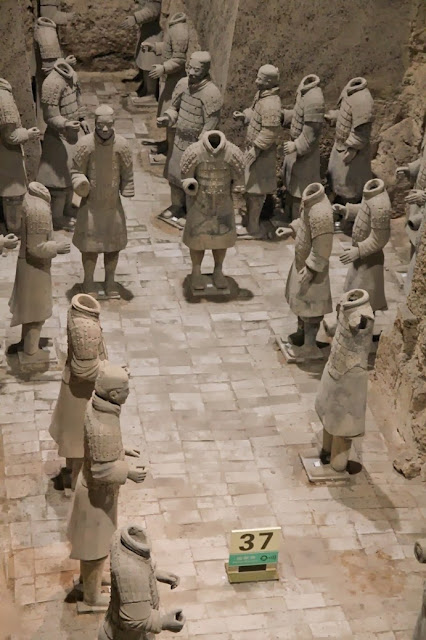 |
| headless warriors |
Pit 2 features mounds that are still probably
undergoing excavations as there was basically nothing much to see. Walking
forward, there are a number of statues in glass boxes in which I had a hard
time appreciating because of the number of crowd lining up to have their
pictures taken, as apparently, this is the closest anyone could get to the
statues. It comprises a display of the different ranks of soldiers and I was
able to see more on how meticulous each of them was created. Face structure and
expressions, hair, uniform, body type - each part is said to have been copied
exactly how a member of the Emperor’s army would look like. The warriors were
once painted with colors but have faded through time and being buried for long.
 |
| warriors in the display |
 |
| mid-ranking officer |
 |
| model for high-ranking officer (with a minion photobomber :P ) |
 |
| archer |
 |
| amazing pose of the kneeling archer with intricate carvings |
Last off was Pit 1 – this is probably the most photographed area here and
the image that also stuck to my mind since I was a kid. This would have been
magical and a dream-come-true moment if not for the noise, crowd, humidity and
just the overall chaos. It was the only time I wished I brought my zoom lens
with me to China to get more detailed shots! There were also restoration work
being done at the background and one could still view the ‘wounded’ and
‘patched-up’ statues. Anyway, I seriously doubt the number of people would lessen
in Pit 1 so I took my time to look around and appreciate this wonderful art. It
is without any question that the site is included in the UNESCO World Cultural
Heritage Sites in China.
 |
| Pit 1 |
 |
| sculptures of infantrymen made out of local clay, baked in the kiln after having been carefully and meticulously designed |
 |
| some of the sculptures that are still undergoing restorations |
 |
| just an overview of the very hard task of having these models |
This is without no
doubt, one of China’s popular tourist attractions. The site was
impressive and its historical contribution is unquestionable, but it was not
just what I expected. Seeing those pictures since I was a child, I was
expecting to be able to see the statues up close, but with the current set-up
they have now, that was impossible since there are still ongoing restoration
work and taking note how fragile the statues are. I also had high hopes for the
“museum” instead there were only few sculptures lined up for more intimate
viewing, and everybody wants a piece of it too, making it hard to really
appreciate it in silence. At that point, I was being fed up by local tourists
who just came to take pictures and not even take a moment to appreciate all the
overwhelming details in front of them. Anyhow, it’s really hard to describe the
feeling of being able to see this with my own eyes. The thrill of meeting these
statues that have stood there for over two millennium was really something else
and was a nice treat for my birthday
 |
| Emperor’s Qin Terracotta Army, Xian - such an unbelievable sight |
P.S. I also strongly recommend that you visit
Yangling Mausoleum of Han Dynasty (Hanyangling).
The sculptures are miniature but the preservation is also of high regard and
you could see them on a more up close level, less the hordes of tourists of
course.
Directions to the Terracotta Army of Xian:
From Xi’An Railway Station, take tourist Bus 306 and it will
take you directly to the site, you can avail the same bus ride going back to
city proper.
Day 1: Datong
City Tour

|
Day 2: Datong
Yungang Grottoes

Hanging Monastery

|
Day 3: Pingyao
City Tour
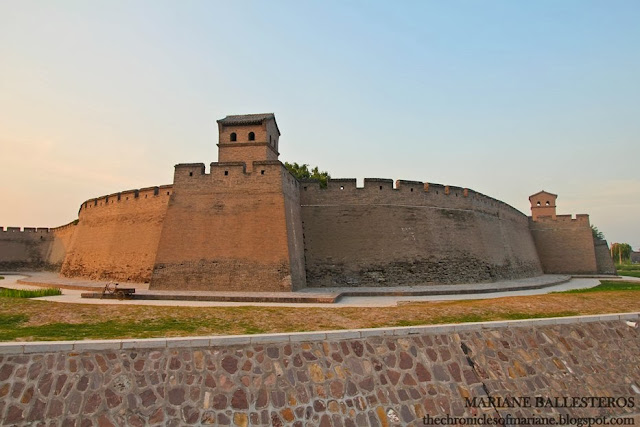
|
Day 4: Pingyao
City Tour and Attractions

|
Day 5: Pingyao
Architecture/Art

|
Day 6: Xi'An
City Tour

|
Day 7: Xi'An
Yangling Mausoleum

|
Day 8: Xi'An
Terracotta Army

|
Day 9: Beijing
Qianmen Street/798 Art District

|
Day 10: Beijing
Nanluoguxiang/
Wangfujing

Tiananmen/
Forbidden City

|
Day 11: Beijing
Summer Palace

|
Day 12: Beijing
Great Wall

|
Railway Train Experience
Standing, Hard Seats, Sleepers

|
12 Day Trip
Itinerary & Budget
.jpg)
|
More of China here























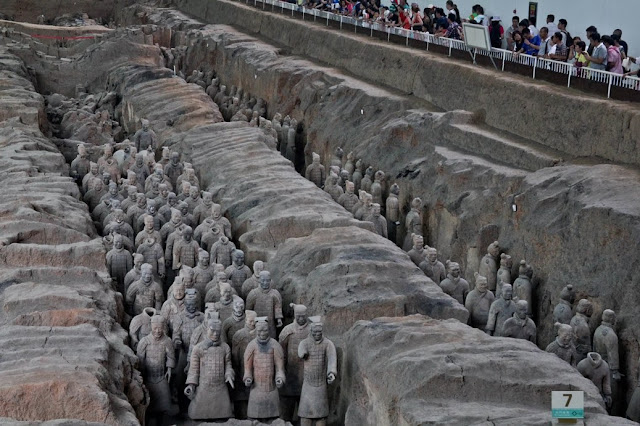

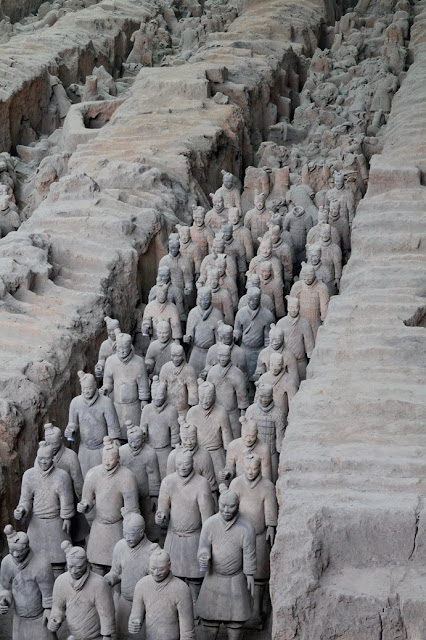



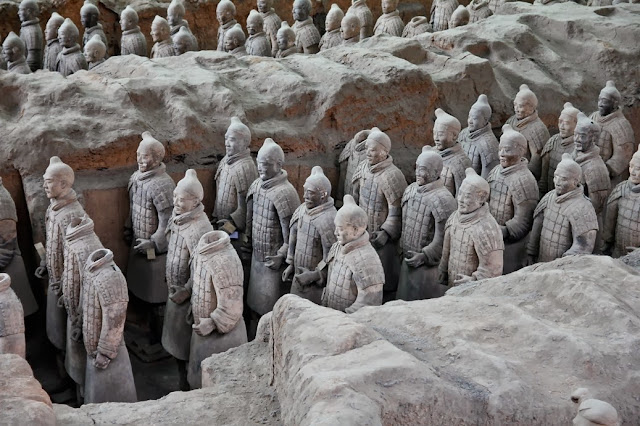















.jpg)
Wow! This is really amazing and it's in my bucket list too. I read somewhere that no two faces of the statues are alike. That, in itself, is a feat for the sculptors of the army. Unless of course they had real life models. But that adds all the more to the "life" and uniqueness of each statue.
ReplyDeleteYes, read that one too, the warriors that I have compared with indeed have different features and poses. It is said that the warriors are patterned to the real warriors during Emperor Qin's reign. Cool right!
DeleteJust like you, Xian is probably the first place I want to step foot on in huge China! Will need to make this come true soon :)
ReplyDeleteThanks Mariane. I just read your blog.
ReplyDeleteMy wife and I visited Xian in September 15. DIY.
Xian is a wonderful city to visit. My wife and I stayed at a small hotel on the Muslim food street for convenience. Though we spoke no mandarin, we visited all attraction by bus, taxi, or walking. Google map on the phone is a very handy tool to know where we were.
I agree, I would love to go back again and follow your lead and stay nearby the Muslim District! I went there without a smartphone and this is a good advice too. Google maps is a very handy tool when traveling j East Asia. Thanks for visiting the blog!
DeleteThanks Mariane. Just read this blog.
ReplyDeleteMy wife and I visited Xian in September 1975. DIY.
I chose a small hotel at the Muslim food street for convenience since we are Muslims.
We didnt take any tour at all. Google map on handphone is a very convenient tool to know our location.